#Oregon Constitution of 1857
Explore tagged Tumblr posts
Text
On June 26, 1844, the legislative committee of the territory then known as “Oregon Country” passed the first of a series of “Black exclusion” laws. The law dictated that free African Americans were prohibited from moving into Oregon Country and those who violated the ban could be whipped “not less than twenty nor more than thirty-nine stripes."
That December, the law was amended to substitute forced labor for whipping. It specified that African Americans who stayed within Oregon would be hired at public auction and that the “hirer” would be responsible for removing the “hiree” out of the territory after the prescribed period of forced service was rendered. This law was enforced even though slavery and involuntary servitude were illegal in Oregon Country.
The preamble to a later exclusion law, passed in 1849, explained legislators’ beliefs that “it would be highly dangerous to allow free Negroes and mulattoes to reside in the Territory, or to intermix with Indians, instilling ... feelings of hostility toward the white race.”
The Oregon Constitution of 1857 included racial exclusion provisions against African Americans and Asian Americans. The document declared that African Americans outside of Oregon were not permitted to “come, reside, or be within” the state; prohibited African Americans from owning property or performing contracts; and prescribed punishment for those who employed, “harbor[ed],” or otherwise helped African Americans.
Between 1840 and 1860, in the midst of this exclusion and discrimination, African Americans never constituted more than 1% of the population in the American Pacific Northwest. Oregon, which joined the Union as a "free state" on February 14, 1859, stands as a clear illustration that racial discrimination and oppression against Black people was also widespread in jurisdictions where slavery was illegal. The 2020 U.S. Census reported that only 3.2% of Oregon residents were Black.
#history#white history#us history#Black history#am yisrael chai#jumblr#republicans#democrats#slavery#Oregon Constitution of 1857#Oregon Constitution#Oregon
57 notes
·
View notes
Photo

Made with the OHS Memory Blanket on July 12, 2024 Collection Patches:
Cecilia Adams’ Diary
(Collection ID 007858),
Debate Over Oregon Constitution
(Collection ID bb016799),
Nez Perce Bible
(Collection ID bb017237),
News Article, The Treaty for Sale of Lands
(Collection ID bb016729),
Black Exclusion Laws in Oregon Constitution
(Collection ID bb016755),
Suffrage Committee Report, 1857
(Collection ID bb016886)
0 notes
Text
Pluralistic: 03 Mar 2020 (School surveillance self-defense, copyright for authors, Facebook's potemkin data-downloader, Oregon GOP's sabotage, and more!)

Today's links
EFF's Surveillance Self-Defense guide for students: Privacy is a team sport.
Oregon's Dems have a supermajority, but the GOP won't show up for work: White nationalism is how plutes get turkeys to vote for Christmas.
A Lever Without a Fulcrum Is Just a Stick: How to design a copyright to protect artists, not corporations.
Facebook neutered "Download Your Data": "Your data" doesn't include a list of ad-tech companies that also hold your data.
The EU's new copyright filters violate the GDPR: We told you so.
Recycling spy agencies' malware for fun and profit: NOBUS is, and always has been, an idiotic idea.
Japanese condiment company releases "sliced mayo": Comes in four flavors!
Department of the Interior climate docs include junk science: Trump's man on the inside, sabotaging our future.
This day in history: 2005, 2010, 2015, 2019
Colophon: Recent publications, current writing projects, upcoming appearances, current reading

EFF's Surveillance Self-Defense guide for students (permalink)
EFF just launched its Surveillance Self-Defense guide for students: it's a soup-to-nuts guide for kids and parents disturbed about social media monitoring, campus facial recognition systems, and "aggression detection" mics in classrooms
https://ssd.eff.org/en/module/privacy-students
It unpacks technical concepts from stalkerware to man-in-the-middle SSL certificates, and includes guides to having difficult privacy conversations with friends, family and officials, and technical guidance for protecting your privacy.
As the press-release notes, "School discipline disproportionately targets students of color, and it's reasonable to think that additional, and more comprehensive scrutiny of their lives will only add to that injustice." These systems also disproportionately affect queer kids, "who tend to look for support online as they explore their gender identities, and find they're under so much surveillance that they learn not to look. They learn not to trust online public spaces."
https://www.eff.org/press/releases/schools-are-spying-students-students-can-fight-back
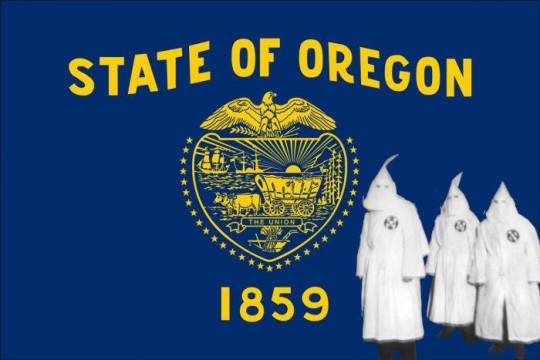
Oregon's Dems have a supermajority, but the GOP won't show up for work (permalink)
In Oregon, Democrats have a supermajority in the House and Senate, because the vast majority of Orgeonians support Democratic policies. But when Oregon drafted its constitution in 1857, it copied the Indiana constitution's provision that sets quorum at 2/3 of lawmakers.
Theoretically, this has meant that if a small handful of opposition lawmakers refused to show up for work, the state legislature would shut down. Practically, neither party has ever done this…until now. The Oregon GOP, acting on behalf of a small number of rural, white, reactionary voters, has refused to enter the statehouse when the majority was calling votes on "guns, forestry, health care, budgeting" and now, the climate crisis.
https://www.vox.com/energy-and-environment/2020/2/29/21157246/oregon-republicans-walk-out-climate-change-cap-trade-democracy
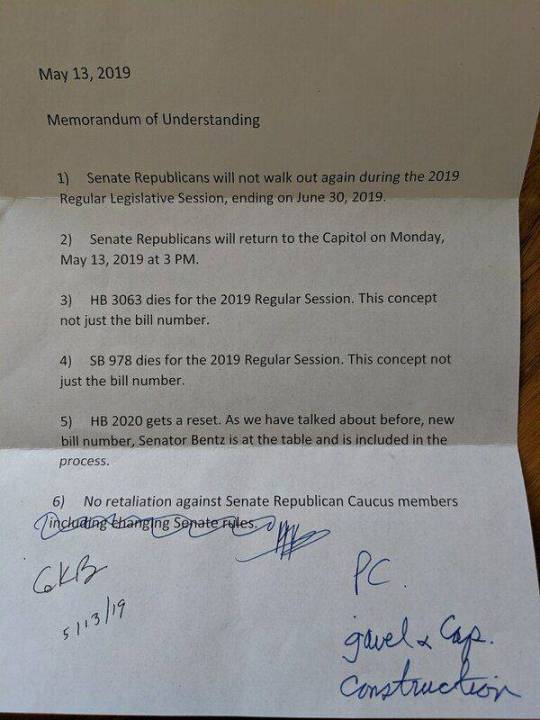
They've killed a small tax raise to fully fund state public schools, modest gun restrictions, and mandatory vaccinations for kids. Then they signed a memo promising not to pull that stunt again, so the legislature could pursue a cap-and-trade bill.
They fucking lied.
GOP Senators went into hiding, and threatened to murder any police officers sent to get them.
Cap and trade is back before the legislature, and the GOP cowards are in hiding again, refusing to show up and do the job the taxpayers are paying them to do. House Republicans have joined their Senate co-conspirators.
A ballot initiative might force them back into their seats, though:
https://www.opb.org/news/article/oregon-union-leaders-initiative-stopping-legislative-walkouts/
The Oregon GOP has fielded a truckload of bullshit to defend their tantrum. They claim the measure has had insufficient "process" to proceed. It's had more process than any other bill in Oregon history.
https://twitter.com/karin_power/status/1232720734813732865?ref_src=twsrc%5Etfw
"Democrats have bent over backward to accommodate GOP objections, layering on more process, making more concessions, but it hasn't changed Republican rhetoric or behavior a whit. GOP objections aren't to the bill's contents or process, but to its existence."
Oregon has some of the nation's loosest money-in-politics laws and the state GOP is awash in money from polluting industries hoping to render the planet unfit for habitation ("first in the country in per-capita corporate donations to politicians")
https://projects.oregonlive.com/polluted-by-money/part-1
"The Republicans who keep walking out on their jobs get 65 percent of their donations from corporations, in particular corporations like Koch Industries with assets that stand to be affected by cap-and-trade."
Democrats have walked out of legislatures, too: decades ago, and over gerrymandering attempts that would have guaranteed eternal minority rule by rendering the majority of state votes irrelevant. When the GOP stages rallies to support its actions, it is supported by 3 Percenters and other violent white nationalist terrorist elements. White supremacy is how the GOP gets turkeys to vote for Christmas.
But Oregon Dems are too timid to call white nationalism out when they see it. They won't run on the issue of the GOP doing corporate bidding with backing from white nationalists.
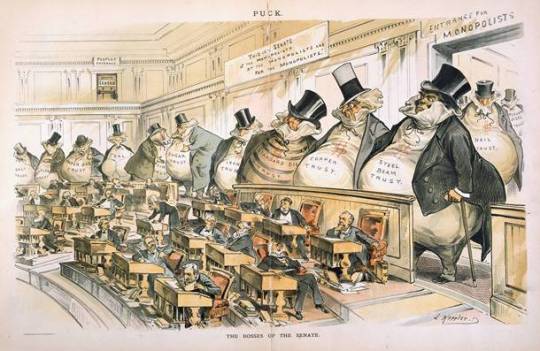
A Lever Without a Fulcrum Is Just a Stick (permalink)
My latest Locus column explores what copyright expert Rebecca Giblin calls "The New Copyright Bargain" – a copyright system designed around enriching authors above all, rather rather than treating authors' incomes as an incidental output of enriching entertainment or tech corporations. The column is called "A Lever Without a Fulcrum is Just a Stick." Copyright is billed as giving creators leverage over the corporations we contract with, but levers need fulcrums.
https://locusmag.com/2020/03/cory-doctorow-a-lever-without-a-fulcrum-is-just-a-stick/
In an increasingly concentrated marketplace, any exclusive rights that are given to creators are simply appropriated by corporations as a non-negotiable condition of the standard contract. Think of how samples could originally be used without permission (in the Paul's Boutique/It Takes a Nation of Millions era), enriching old R&B artists who'd been burned by one-sided contracts.
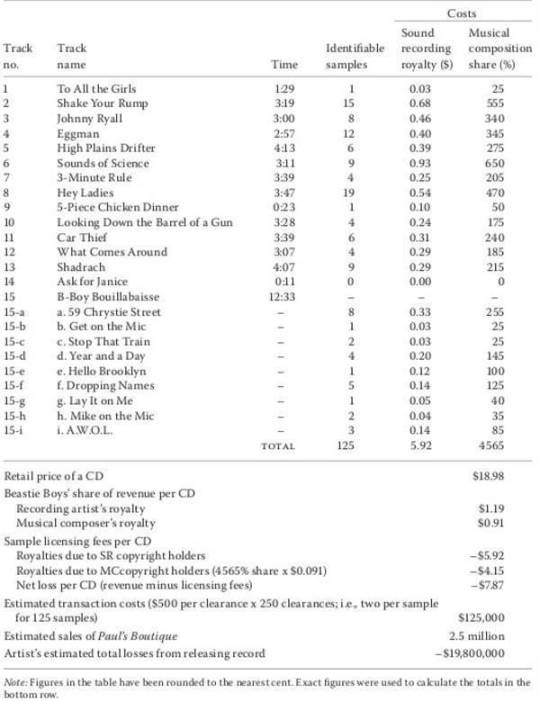
(Image from Kembrew Macleod's "Creative License" https://www.dukeupress.edu/creative-license)
Those artists experienced a temporary enrichment when paying for samples became the norm, but today, all contracts simply require signing away your sampling rights. The fight to require licenses for samples merely gave the labels yet another right to demand of their artists. Which means that anyone hoping to sample must sign to a label and pay for a license either to that label or one of the other three. Giving new rights to artists in a monopolized market is like giving your bullied kid more lunch money. It doesn't buy the kid lunch, it just gives the bullies the opportunity to take more money from your kid.
After the "Blurred Lines" suit, labels have begun to fret about being sued over artists' copying the "vibe" of another artist. It's easy to feel smug about copyright maximalists being hoist on their own petards. But the end-game is easy to see: just make selling your "vibe" rights a condition of signing a record deal, and you transfer ownership of whole genres to the Big 4 labels.
What would a copyright look like that protected artists, rather than practicing the Magic Underpants Gnome method of:
Enrich entertainment corporations;
?????
Artists get more money
Any new bargain in copyright centered on artists needs to take account of the concentration in tech and entertainment, and create rights for artists that aren't just creator's monopolies to be scooped up through non-negotiable contracts. Measures like reversion (which lets artists in the USA claim back rights they signed away 35 years ago), blanket licenses (designed to pay artists regardless of whether they're "rightsholders"), and restoring unionization rights are the key to paying artists.
Merely expanding the "author's monopoly" does no good in a world of industrial monopolies: it just gives those monopolists more ammo to use in the fight to shift revenues onto their own balance sheets, at the expense of working creators.

Facebook neutered "Download Your Data" (permalink)
Facebook recently unveiled a feature called "download your data," partly to comply with Europe's GDPR. But as Privacy International reveals, there's a very important omission in the data that Facebook will release to you.
https://privacyinternational.org/long-read/3372/no-facebooks-not-telling-you-everything
Missing from "your data" is the list of advertisers whose targeted you by uploading some of your personal information (through the "Custom Audience" tool) – that is, the list of other companies that the GDPR lets you send data-requests to. This omission means that you can't use FB as a jumping-off point to discover all the data being held on you by all the advertisers, data-brokers, etc. It's not an accident, either: Facebook replicates this in their new "Off-Facebook" product.
Facebook is under increasing pressure to allow competition through interoperability, but argues that it can't possible protect your privacy if they are forced to allow companies that you trust to manage your Facebook experience for you. In other words, Facebook argues that it can't be a wise, benevolet steward of your privacy if you insist on allowing competitors to interfere with it. But that argument only works if you trust Facebook — and who the hell trusts Facebook?
(And why on Earth would you?)

The EU's new copyright filters violate the GDPR (permalink)
The EU's Copyright Directive effectively forces all online platforms to implement upload filters that scan everything you try to post and refuses anything that matches a database of works that anyone, anywhere has claimed to be "copyrighted." This a terrible idea in an era of rampant copyfraud. The Directive has no penalties for people who falsely claim copyright even when it's to rip off, blackmail or censor artists, and platforms still have to accept their copyright claims even after they're caught at it.
But it's also a massive violation of Article 22 of the GDPR, which promises users the right "not to be subject to a decision based solely on automated processing which produces legal effects concerning them or significantly affects them."
https://www.eff.org/deeplinks/2020/02/upload-filters-are-odds-gdpr
That is to say, you aren't allowed to do the kind of filtering that Article 17 of the Copyright Directive mandates. Billions of pieces of "personal information" (under the GDPR's definition) will be processed by copyright bots every day, and that's illegal.
None of the GDPR's exemptions apply, either. For example, the Copyright Directive doesn't "authorise" the filtering, because its authors explicitly deleted all mentions of filters in order to get the Directive passed, and publicly disclaimed any filtering mandate.
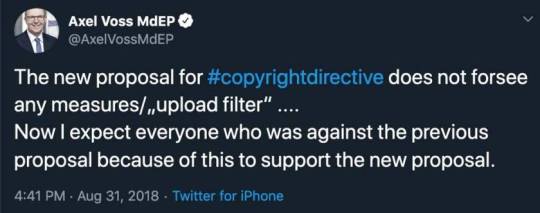
Nor is filtering "necessary" for the use of the service under the GDPR – the services run today without filtering, so the GDPR's narrow, rigorous definition of "necessity" does not apply.
The GDPR does allow this kind of processing with "consent" but not the kind where you click a terms-of-service "OK" button. Consent under GDPR has to include the ability to say no and still use the service.
What's more, the Copyright Directive includes new EU-wide copyright exceptions for parody and criticism, and while it's impossible to imagine a filter being able to tell the difference between parody/criticism and other kinds of speech, any attempt will be a privacy disaster. Identifying parody/criticism requires understanding of context – and that means that a filter trying to discern these concepts will have to consider huge amounts of personal information to make its determination. And the Copyright Directive itself does not allow any system that fails to respect these "fundamental rights" of internet users, which means that you can't use a filter unless it can grasp these distinctions.
Literally all of this was obvious from the start, and boosters of upload filters hand-waved them away, insisting they were mere technicalities that could be solved by asking tech companies to NERD HARDER. Now, the whole thing is likely to fall apart.

Recycling spy agencies' malware for fun and profit permalink)
The NSA has a doctrine called "NOBUS," which stands for "No One But Us" — as in, "It's OK if we keep these bugs we discovered a secret because no one but us is smart enough to find or exploit them." But as ex-NSA hacker Patrick Wardle's RSA presentation, "Repurposed Malware: A Dark Side of Recycling" shows, foreign spy agencies – and criminals – love NOBUS because it means they get to steal NSA cyberweapons and use them for themselves.
https://www.rsaconference.com/usa/agenda/repurposed-malware-a-dark-side-of-recycling
Once you discover a snippet of malicious code in the wild (either something used by a spy agency and then blown, or something stolen from the agency), it's really easy to remix it to deliver your own malware.
In his demo, Wardle showed how he replaced a small section of the pioneering fileless Macos malware AppleJeus.c and created his own, virus-scanner-resistant strain.
https://arstechnica.com/information-technology/2020/02/why-write-your-own-mac-malware-when-you-can-rip-off-a-competitors-a-how-to/
"With a single modification to the binary, (and building a light-weight C&C server), we now have access to an advanced nation-state loader that will perform to our bidding …without having to write any (client-side) code!"
NOBUS is, and always has been, a dead letter – equivalent to stockpiling superbugs to use as bioweapons, in hopes that no one else will discover or steal them, rather than developing a vaccine for them. It's the height of irresponsibility, and your tax-dollars pay for it.

Japanese condiment company releases "sliced mayo" (permalink)
The Japanese condiment company Bourbon just released a "sliced mayonnaise" product similar to American cheese singles. It'll come in flavors like "spicy tuna" and "cod roe."
https://www.atpress.ne.jp/news/205437
It's an addition to the company's existing sliced condiment products, like "sliced chocolate."
https://soranews24.com/2020/02/21/sliced-mayonnaise-and-white-chocolate-now-exist-in-japan-bringing-sandwiches-to-glorious-new-era/
The sliced mayo is ¥200-250, and comes in packets of four. Honestly, I'm fine with this except for the plastic – if it came in an edible wrapper, it'd make for an excellent picnic/school lunch supply.
https://www.foodandwine.com/news/mayonnaise-slices-japan
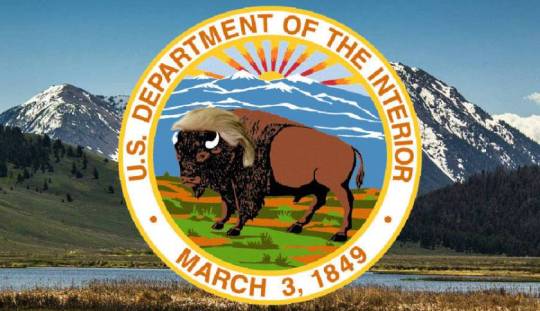
Department of the Interior climate docs include junk science (permalink)
When Trump took office, he promoted Indur M Goklany, a climate denier, to the office of the deputy secretary "with responsibility for reviewing the agency's climate policies."
https://www.nytimes.com/2020/03/02/climate/goks-uncertainty-language-interior.html
Ever since, Goklany has been inserting debunked climate-denial talking points into US government science, including the myth that "increased carbon dioxide in the atmosphere is beneficial." Longtime agency staffers exchange private, grim jokes about being forced to insert "Goks uncertainty language" into their communications about the climate crisis, howlers like the idea that rising CO2 "may increase plant water use efficiency."
"The Interior Department declined to make Mr. Goklany available for an interview, and he did not return requests seeking comment."

This day in history (permalink)
#15yrsago Free Software Foundation tears MPAA a new one in Grokster brief http://moglen.law.columbia.edu/publications/grokster-amicus.pdf
#10yrsago Blind gamer speedruns Zelda with help of 100,000+ keystroke script https://boingboing.net/2010/03/03/blind-gamer-speedrun.html
#5yrsago Ed Snowden says he'll face trial in the US https://news.yahoo.com/edward-snowden-ready-return-states-144245040.html
#5yrsago Razorhurst: blood-drenched gang warfare and ghosts in Gilded Age Sydney https://boingboing.net/2015/03/03/razorhurst-blood-drenched-gan.html
#1yrago The FAIR Act will end forced arbitration for employment, consumer, antitrust and civil rights disputes https://thinkprogress.org/lawmakers-declare-war-on-the-biggest-civil-rights-problem-youve-probably-never-heard-of-eaf3b5459034/
#1yrago Google says it won't remove Saudi government app that lets men track and monitor their wives and domestic employees https://www.businessinsider.com/absher-google-refuses-to-remove-saudi-govt-app-that-tracks-women-2019-3
#1yrago Record label censors copyright lawyers' site by falsely claiming it infringes copyright https://spicyip.com/2019/02/saregama-pa-rdon-me-you-have-the-wrong-address-on-the-perils-and-pitfalls-of-notice-and-takedown.html
#1yrago German data privacy commissioner says Article 13 inevitably leads to filters, which inevitably lead to internet "oligopoly" http://www.fosspatents.com/2019/02/germanys-federal-data-protection.html#translation
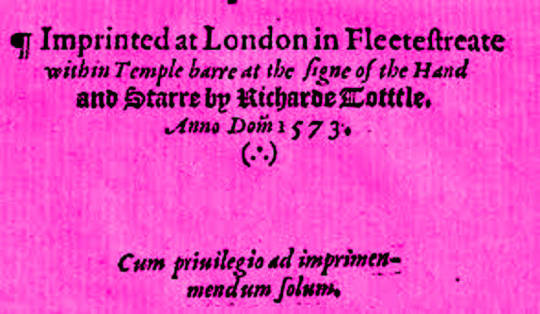
Colophon (permalink)
Today's top sources: Waxy (https://waxy.org/), Four Short Links (https://www.oreilly.com/feed/four-short-links), Slashdot (https://slashdot.org), Kottke (https://kottke.org).
Hugo nominators! My story "Unauthorized Bread" is eligible in the Novella category and you can read it free on Ars Technica: https://arstechnica.com/gaming/2020/01/unauthorized-bread-a-near-future-tale-of-refugees-and-sinister-iot-appliances/
Upcoming appearances:
Canada Reads Kelowna: March 5, 6PM, Kelowna Library, 1380 Ellis Street, with CBC's Sarah Penton https://www.eventbrite.ca/e/cbc-radio-presents-in-conversation-with-cory-doctorow-tickets-96154415445
Currently writing: I just finished a short story, "The Canadian Miracle," for MIT Tech Review. It's a story set in the world of my next novel, "The Lost Cause," a post-GND novel about truth and reconciliation. I'm getting geared up to start work on the novel now, though the timing is going to depend on another pending commission (I've been solicited by an NGO) to write a short story set in the world's prehistory.
Currently reading: Just started Lauren Beukes's forthcoming Afterland: it's Y the Last Man plus plus, and two chapters in, it's amazeballs. Last month, I finished Andrea Bernstein's "American Oligarchs"; it's a magnificent history of the Kushner and Trump families, showing how they cheated, stole and lied their way into power. I'm getting really into Anna Weiner's memoir about tech, "Uncanny Valley." I just loaded Matt Stoller's "Goliath" onto my underwater MP3 player and I'm listening to it as I swim laps.
Latest podcast: Disasters Don't Have to End in Dystopias: https://craphound.com/podcast/2020/03/01/disasters-dont-have-to-end-in-dystopias/
Upcoming books: "Poesy the Monster Slayer" (Jul 2020), a picture book about monsters, bedtime, gender, and kicking ass. Pre-order here: https://us.macmillan.com/books/9781626723627?utm_source=socialmedia&utm_medium=socialpost&utm_term=na-poesycorypreorder&utm_content=na-preorder-buynow&utm_campaign=9781626723627
(we're having a launch for it in Burbank on July 11 at Dark Delicacies and you can get me AND Poesy to sign it and Dark Del will ship it to the monster kids in your life in time for the release date).
"Attack Surface": The third Little Brother book, Oct 20, 2020.
"Little Brother/Homeland": A reissue omnibus edition with a very special, s00per s33kr1t intro.
18 notes
·
View notes
Text
A brief history of the United States by President
Revolutionary
1. George Washington (1789-1797) -Founding Father; served as Commander in Continental Army during the American Revolution. -Established system of taxation & National Bank. -First term largely preoccupied with capturing Ohio Country through irregular (ranger) warfare.
2. John Adams (1797-1801) -Another Founding Father; Leader in the movement for American Independence. -Fierce criticism from Jeffersonian Republicans; rivals with Alexander Hamilton. -Passed Alien & Sedition Acts making it harder for immigrants to become citizens.
3. Thomas Jefferson (1801-1809) -Founding Father; Principle author of the Declaration of Independence. -Louisiana Purchase doubling country’s territory - involved Indian Removal policy. -Act Prohibiting Importation of Slaves in 1807 (but owned hundreds); domestic slave trade still allowed, and slaves also continued to be imported in limited numbers. -Lewis & Clark expedition to explore Louisiana Territory and gain intelligence on Indigenous nations; Pike Expedition to present-day Colorado to gain intelligence on Mexico. -Invasion of Barber nation in North Africa against pirate attacks on US merchant ships.
4. James Madison (1809-1817) -Founding Father hailed as “Father of the Constitution” and Bill of Rights (drafted first 10 amendments). -Led US into War of 1812 over British trade restrictions - peace in 1815 with no boundary changes. -Ohio Country war still waging, along with war against Muskogee Nation in South 1813-14, culminating in elimination of Indigenous powers east of the Mississippi.
5. James Monroe (Era of Good Feelings) (1817-1825) -Last President who was a Founding Father. -Sent Jackson to Florida to fight in first Seminole War and retrieve runaway slaves (1818). -Ratified Adams-Onis Treaty of 1819, buying Florida from Spain and extending US to the Pacific (with Southern border running through Sabine River/Rocky Mountains). -Monroe Doctrine policy of opposing European colonialism & intervention in the Americas. -Office of Indigenous Affairs established in 1824 (within the Department of War for the first 25 years).
6. John Quincy Adams (1825-1829) -With high tariffs got rid of most national debt, pushed for road & canal construction. -Easy foreign policy because of his eight proceeding years as Secretary of State. -Semi-tried to defend Native Americans on the frontier.
Jacksonian
7. Andrew Jackson (1829-1837) -Beginning of spoils system in US politics. -Fought against Muskogees and in Seminole Wars (an Everglade-area nation born of resistance to colonizers) before administration - as president, waged Second Seminole war in attempt to get Seminoles to leave FL altogether. -Indian Removal Act 1830 (Trail of Tears) forcibly relocated many tribes from the South to Oklahoma. -86 treaties with 26 Indigenous nations between New York and Mississippi forcing land sessions and removals during Jacksonian era. -Supreme Court ruled in favor of Cherokees keeping their land in Georgia; Jackson ignored them. -Collaborated with South to keep abolitionist literature out of the mail.
8. Martin Van Buren (1837-1841) -Blamed at the time for the Panic (depression) of 1837. -1838 US Army’s forced march of Cherokee Nation from Georgia/Alabama to northern Oklahoma during the dead of winter; half of the entire Cherokee population died - originating term Trail of Tears. -Denied the application of Texas for admission to the Union - didn’t want to upset balance of slave versus free states; didn’t want to upset Mexico (who still need not recognize TX independence). -Increasingly abolitionist later in life post-presidency.
9. William Henry Harrison (31 days in 1841) -Elected president largely based on success in battle of Tippecanoe, stealing Indigenous land in Indiana in 1811. -Died of pneumonia, running mate John Tyler took his place (first president to die in office).
10. John Tyler (1841-1845) -Firm believer in Manifest Destiny, territorial expansion included negotiating the annexation of the independent Republic of Texas (final process carried out by his successor Polk). -Originally chosen as Whig VP to increase voter base; did not have support of either Democratic or Whig parties; presidency viewed in low consequence/esteem by historians.
11. James K. Polk (1845-1849) -Acquired land in Oregon territory (from British occupiers) and finalized process of annexation of Texas (increasing tensions with Mexico). -As direct consequence, began the Mexican-American War 1846-1848, ending in Treaty of Guadalupe Hidalgo and establishing current US-Mexico border. Gold rush to California began directly following.
12. Zachary Taylor (1849-1850) -Working to establish statehood and borders of California, Utah, New Mexico and Texas - which also involved disputes over slavery. -Died after falling ill from eating excessive raw fruit & ice milk at a presidential event for Fourth of July.
13. Millard Fillmore (1850-1853) -As Taylor’s VP assumed position when he died. -Compromise of 1850 admitted California as new state, decided borders between Utah, NM, TX, and which of those would be allowed slaves, included Fugitive Slave Act which required escaped slaves even in free states to be turned in to their masters if found out; temporarily eased tensions between North & South.
Civil War & Reconstruction
14. Franklin Pierce (1853-1857) -Kansas-Nebraska Act created new official territories, leading to new disputes between pro- and anti-slavery forces. Settlers from both sides flooded the areas to influence politics. -Enforcement of the Fugitive Slave Act angered Free Staters and set stage for Southern secession and Civil War. -Third Seminole War (1855-58) ended with most of remaining Seminoles forcibly relocated to Oklahoma.
15. James Buchanan (1857-1861) -Introduced Kansas as a slave state. -Unable to stop the Civil War from coming to a head. -Before his inauguration, pressured Supreme Court on Dred Scott case of 1857, to decide black people could not be considered citizens.
16. Abraham Lincoln (1861-1865) -Lincoln’s nomination prompted the Confederate States formation and secession before he even took office. -Led US through Civil War to preserve the Union; at the same time, US army militias fighting wars against Indigenous nations in the West including the forced 300-mile Long Walk of the Navajo in 1864. -1862: Homestead Act opened up land West of Mississippi to small independent ownership by any white settler who hadn’t taken up arms against the government; Morril Act land grants to form Agricultural/trade colleges in each state; Pacific RR Act land grants directly to corporations to start building RR from MI River to Sacramento, CA - breaking multiple treaties with Indigenous Nations. -Abolished slavery in 10 seceded states with the Emancipation Proclamation of 1863; all slaves declared free with the 13th Amendment which soon followed in 1864 (thus allowing freed slaves to fight in the Union Army as well as in the West). -Re-elected to a second term but assassinated in 1865, five days after Confederate surrender.
17. Andrew Johnson (1865-1869) -Quick Reconstruction efforts, lenient toward South, no protection for former slaves, no support for black suffrage (allowed Southern states to enact Black Codes, almost same as slave conditions). -Would not sign Civil Rights Bill of 1866 - to grant citizenship to all persons born in US - but Congress overrode his veto. -Impeached by an angry House of Representatives on the grounds of violating Tenure of Office Act (which he did to purposefully challenge them) - though acquitted in the Senate by one vote. -14th Amendment in 1868 repudiated Dred Scott decision, declaring all people born in US citizens.
18. Ulysses S. Grant (1869-1877) -Continued Reconstruction, readmitting Southern states but doing better to ensure rights for black citizens. -15th Amendment secured black vote in 1870. -US entered period retrospectively called Gilded Age, with economic growth and industrialization ahead of Britain (factories, railroads, coal mines). -War to Win West: US Army (largely blacks and recent immigrants) sent to kill buffalo to near extinction in order to destroy Plains Nations food supply. -In 1871 Congress halted all further formal treaty-making with Indigenous Nations, no longer recognizing them as sovereign. -Advocate of citizenship and government participation for Native Americans (Indian removal had been policy up until then); Boarding School model started under Grant presidency to assimilate Indigenous folks. -Great Sioux War of 1876 fought over gold in the Black Hills - seized land where Mount Rushmore would be built; still fighting to get it back (Sioux won’t accept money). -Established first National Park at Yellowstone (1872). -Civil Rights Act of 1875 guaranteeing equal treatment in public accommodations.
Industrial Revolution & Gilded Age
19. Rutherford B. Hayes (1877-1881) -Elected in Compromise of 1877; deal forced him to end reconstruction (army support) in Southern states. -Great Railroad Strike of 1877 - the first nationwide work stoppage - lasted 45 days and was put down by federal troops; army often siding on the side of big business as economy industrialized. -Congress passed Burlingame-Seward Treaty limiting number of immigrants allowed to come to US from China. -Assimilationist/land seizure policy towards Native Americans; removal of Ponca tribe from Nebraska to Oklahoma.
20. James A. Garfield (1881) -Assassinated by Charles Guiteau, who was offended by Garfield’s rejections on various job applications.
21. Chester A. Arthur (1881-1885) -Pendleton Civil Service Reform Act establishing that position within government should be granted on basis of merit rather than ties to politicians or political affiliation. -Congress passed Chinese Exclusion Act of 1882, banning new immigrants and denying citizenship to those already arrived.
22. Grover Cleveland (1885-1889) -Expanded upon Chinese Exclusion Act with the Scott Act, banning return of immigrants if they left. -Dawes Act of 1887 authorizing the President to survey American Indian lands and divide it into allotments for individual Indians - those who accepted the allotments were to be granted US citizenship. Designed to make Indigenous folks competitive against one another in the “healthy” capitalist manner - in the process reduced Indian territories by half. Also triggered “Oklahoma Run” of 1889.
23. Benjamin Harrison (1889-1893) -Passed McKinley tariff to protect against foreign competition (overturned by Cleveland) -Passed Sherman Antitrust Act to prevent artificial price raising through monopolies or cartels. -Facilitated creation of National Forests. -By 1890s most Indigenous refugees were confined to reservations. Wounded Knee massacre of Sioux in 1890 is considered to mark end of armed Indigenous resistance. -Annexation of Hawaii during last days in office (overturned by Cleveland’s administration which followed)
24. Grover Cleveland (term 2, 1893-1897) -Acute economic depression right after he took office - “Panic of 1893” -Used military action to end Pullman Railroad Strike in Chicago and other rail centers around the country.
Overseas Imperialism
25. William McKinley (1897-1901) -Intervention in Cuban independence from Spain - USS Maine explosion as impetus for war. -Spanish-American War of 1898 ended Spanish colonial rule in the Americas and resulted in US acquisition of PR, Guam, and the Philippines. -More protective tariff policies as during Harrison’s presidency. -Assassinated by Polish-American anarchist Leon Czolgosz.
Progressivism
26. Theodore Roosevelt (1901-1909) -Dedicated conservationist - 200 million acres to national forests, reserves, and wildlife refuges. -“Speak softly and carry a big stick” - believed in American responsibility as a world power. -Roosevelt Corollary meant US would serve as an international police power of sorts… -Helped Panama gain independence from Colombia in order to spearhead construction of Panama Canal. -Nobel Prize for negotiations to end the Russo-Japanese War 1904-05.
27. William Howard Taft (1909-1913) -More than 300lbs - rumored to have gotten stuck in the White House bathtub. -Chief Justice of Supreme Court after presidency (only president to have held the position) -Constitutional amendments mandating a federal income tax (16th) and the direct election of senators by the people, two per state (17th).
World War I
28. Woodrow Wilson (1913-1921) -World War I, 1914-1918 - tried to keep US neutral but ultimately declared war on Germany in 1917. -Immigration Act of 1917 with literacy requirements and Asiatic Barred Zone (Wilson tried to veto). -After war, helped to negotiate a peace treaty including plan for League of Nations (peacekeeping intergovernmental organization which lasted until WWII). -Established Federal Reserve (regulation of banks) and Federal Trade Commission (investigation of unfair business practices) -Child Labor outlawed, institution of 8-hour work day for railroad workers. -Ordered US occupation of Dominican Republic when the country was unable to come to political stability (1916-1922) -19th Amendment ratified in 1920, granting women the right to vote. -First Red Scare at height in 1919-1920 - in the wake of WWI hyper-nationalism, labor movements, and the Russian Revolution.
Roaring Twenties
29. Warren G. Harding (1921-1923) -Supported trade with Soviet Russia (USSR established in 1922) -Ended US occupation of Dominican Republic, also withdrew troops in Cuba. -Limited immigration with Per Centum Act of 1921, quota system for non-Western European immigrants. No limits yet on Latin American immigrants. -Pro-business policies - taxes reduced for corporations and the wealthy. -Federal Highway Act of 1921 - program to develop immense national highway system. -Died from heart attack while in office.
30. Calvin Coolidge (1923-1929) -Roaring 20s of materialism and excess. -Laissez-faire policies (minimum government interference) contributing to Great Depression to come. -Charles Lindbergh made first solo airplane flight across Atlantic in 1927; by now most people owned automobiles and purchased mass-produced goods such as canned food. -Indian Citizenship Act of 1924 granting US citizenship to all Indigenous people - assimilationist at a time when Indigenous populations were already very small, threatening to dissolve the races entirely.
Depression
31. Herbert Hoover (1929-1933) -Great Depression stock market crash seven months after taking office, and economy kept getting worse. -Construction of Hoover Dam started in 1931 (project authorized by Coolidge and dedicated by Roosevelt). -Belief in limited role of government and against federal intervention meant he avoided offering any direct relief to Americans - became deeply unpopular for this.
World War II
32. Franklin D. Roosevelt (1933-1945) -13 million unemployed when he entered office. -Open press conferences and national radio addresses directly to the American people - “Fireside chats.” -New Deal programs and reforms: Agricultural Adjustment Administration, Public Works Administration, Civilian Conservation Corps, Tennessee Valley Authority. -FDIC to protect bank depositors’ accounts; Securities and Exchange Commission to regulate stock market. -Second New Deal programs: Social Security Act (unemployment, disability, pensions), Works Progress Administration giving public works jobs to the unemployed until WWII. -Indian Reorganization Act/Wheeler-Howard Act of 1934 reversing goal of assimilation and reestablishing some sovereignty for Indigenous nations. -Entered World War II after Japan bombed US Naval base at Pearl Harbor in 1941. -Bracero Mexican guest worker Program initiated in 1942. -Elected four times and died in office in 1945.
Cold War
33. Harry S. Truman (1945-1953) -Indigenous Claims Court established 1946 (with deadline of 1951) - but could take 15 years to get a tiny percentage of a claim. -Germany surrendered during first few months in office; Japan refused, so Truman made the decision to use atomic bombs in August 1945. -Deteriorating U.S.-Soviet relations led to start of Cold War (1946-1991) - efforts to constrain Communism included Truman Doctrine aid to Greece & Turkey; and Marshall Plan, giving billions of dollars in aid to rebuild postwar Europe. -CIA first formed in 1947 (to be expanded under Eisenhower). -Second Red Scare gaining momentum also in 1947, with Truman requiring all federal employees to be screened for “loyalty.” -Fair Deal policies including Housing Act of 1949, giving money for public housing and urban renewal/slum clearance. -Supported creation of NATO North Atlantic Treaty Org. military alliance between US, Canada, France, UK, and others. -Led US into Korean War (1950-53) when communist North Koreans invaded South Korea.
Cold War - Vietnam War
34. Dwight D. Eisenhower (1953-1961) -Termination Act in 1953 terminated government recognition of more than 100 tribes, much land trust taken, also terminated funding for social welfare programs (civil rights organizing caused government to cease this policy in 1961, though only officially repealed in 1988). -Indian Relocation Act in 1956 to encourage individuals to leave reservations and assimilate. -Ended Korean War in 1953; managed Cold War tensions with covert CIA operations around the world (leading to government overthrows in Iran, Guatemala with PBSUCCESS, Indonesia, Congo, Chile, Greece). -Trade and Military alliance with Franco administration in Spain. -Strengthened Social Security, created Department of Health, Education, and Welfare. -Massive new Interstate Highway System (wide enough for jet landings). -Operation Wetback in early 1954, border patrol locating and quickly deporting Mexicans with and without legal status - Border Patrol agents doubled by 1962. -Senator McCarthy crusade culminated in 1954 - Eisenhower worked privately to discredit him. -Brown v. Board of Ed. school desegregation mandate by Supreme Court in 1954, though not fully enforced; did pass civil rights legislation (first since Reconstruction) to help protect black voters in 1957 & 1960. The 1957 legislation also secured the vote for Indigenous Americans. -Support for anti-Communist government in South Vietnam sowed the seeds for future Vietnam War (official beginning in 1955 training the Army of the Republic of Vietnam). -Coined the term military-industrial complex in his farewell address.
35. John F. Kennedy (1961-1963) -Failed Bay of Pigs 1961 mission to send CIA-trained Cuban exiles to overthrow Cuba’s Castro government. -Cuban Missile Crisis 1962 US naval blockade of Cuba in response to rumored Soviet weapon build-up in Cuba, ended in both countries backing down with nuclear weapons. -Launched the Peace Corps. -Sent troops to support desegregation at University of Mississippi and endorsed 1963 March on Washington (MLK’s I Have A Dream speech). -Assassinated in November 1963 in Dallas, TX by Lee Harvey Oswald.
36. Lyndon B. Johnson (1963-1969) -Introduced programs including Medicare/Medicaid and Head Start. -Civil Rights Act of 1964 ending segregation in public places and banning employment discrimination, and Voting Rights Act of 1965. -Occupation of Chagos island for US military base began in 1968 and concluded in 1973. -Steadily escalated US military involvement in Vietnam War (16k to 500k troops). -Occupation of Alcatraz in 1969 by pan-national Indigenous organizers, lasting 19 months.
37. Richard Nixon (1969-1974) -Formation of Environmental Protection Agency, Clean Air Act of 1970, OSHA (for workplace health and safety). -First land restitution to any Indigenous nation in 1970, Blue Lake returned to Taos Pueblo. -Worked closely with National Security Adviser Henry Kissinger in covert resistance - eg. assassination of Allende in Chile, leading to Pinochet assuming power in 1973. -Gradually withdrew troops (increasing air strikes instead); signed Paris Peace Accords ending Vietnam War in 1973. -1973 oil crisis due to OPEC embargo, cause by US support for Israel. -Resigned in 1974 rather than facing impeachment over Watergate scandal (administration broke into DNC headquarters during 1972 bid for re-election).
Cold War - Contemporary
38. Gerald Ford (1974-1977) -Pardoned Nixon in 1974. -Education for All Handicapped Children Act of 1975, which established special education throughout the United States.
39. Jimmy Carter (1977-1981) -Unconditional amnesty for Vietnam War-era draft evaders. -Handed over Panama Canal to Panama authority. -1979 (second) oil crisis following Iranian Revolution - greatly exacerbated by widespread consumer panic. -Presided over 1977 Camp David Accords ending war between Israel and Egypt since Israel’s creation in 1948.
40. Ronald Reagan (1981-1989) -Tax Cuts for wealthy intended to spur growth (known as Reaganomics, “trickle-down economics”), meanwhile freezing minimum wage; increased military spending and reductions in social programs; deregulation of business. -Appointed Sandra Day O’Connor, first woman to serve on US Supreme Court. -Escalation of Cold War through massive buildup of weapons and troops; Reagan Doctrine provided aid to anticommunist movements in Africa, Asia, Latin America; diplomatic talks with Gorbachev ultimately leading to (unofficial) end of Cold War just after he left office. -Invaded Grenada after Marxists took power of the government. -Announced the War on Drugs in 1982 in response to increased concerns around the crack epidemic; reinforcement bill in 1986 with mandatory minimum sentences. -Largely ignored the AIDS epidemic - 36k diagnosed and 21k died before he acknowledged. -Signed Immigration Reform and Control Act of 1986, making it illegal to knowingly hire undocumented people. -Illegally funded Contra rebels fighting against Sandinista government in Nicaragua in 1986.
Contemporary
41. George H.W. Bush (1989-1993) -Fall of Berlin Wall and collapse of Soviet Union came early in his presidency. -Ordered military operations in Panama (Operation Just Cause against Noriega government) and Gulf War (in response to Iraqi leader Saddam Hussein’s invasion of Kuwait). -Americans with Disabilities Act of 1990 prohibiting discrimination. -Immigration Act of 1990 increasing available visas, esp. in skilled workforce. -Spearheaded negotiations for NAFTA, eliminating tariffs between US/Mexico/Canada.
42. Bill Clinton (1993-2001) -Family and Medical Leave Act of 1993 for pregnancy or serious medical conditions. -Brady Bill mandating federal checks on firearm purchases. -Don’t Ask Don’t Tell allowing gay men and women to serve in armed forces if they kept sexuality a secret. -Signed NAFTA into effect in 1994. -Operation Gatekeeper in 1994 - large buildup of policing on the border, especially in heavily trafficked crossing points; started building border wall barriers in 1994 in California, Texas, and Arizona. -Expansion of death penalty to include large-scale crime such as large drug enterprises in Omnibus Crime Bill. -Defense of Marriage Act 1996 reiterating marriage as between a man and a woman. -In 1998 impeached by House for perjury and obstruction of justice related to the Lewinsky scandal but acquitted by Senate. -Assassination attempt by Osama Bin Laden - several unsuccessful military missions to capture him followed. -1998 State of the Union Address warned Congress that Iraqi dictator Saddam Hussein was building an arsenal of chemical, biological and nuclear weapons.
43. George W. Bush (2001-2009) -Sept 11 2001 terrorist attacks - launched War on Terror invading Afghanistan, then Iraq searching for weapons of mass destruction. -Huge spending and tax cuts. -No Child Left Behind Act 2001 - education reform with great emphasis on testing. -Hurricane Katrina devastation to New Orleans with little federal action in response.
44. Barack Obama (2009-2017) -First Black president. -Repealed Don’t Ask Don’t Tell; Supreme Court 2015 decision affirming same-sex marriage. -Health care reform through Obamacare. -Scaled back forces in Iraq, Afghanistan; captured and killed Osama BinLaden.
45. Donald Trump (2017)
1 note
·
View note
Text
PART 1, US HISTORY OF THE AMERICAN WOMAN'S RIGHTS MOVEMENT
Rights Movement in the U.S. History of the American Women's Rights Movement 1848–1920 by Ann-Marie Imbornoni Discover the key events of the women's rights movement in the United States. This timeline covers the years of 1848 to 1920, which includes the famed women's rights convention in Seneca Falls, N.Y., the formation of the National American Woman Suffrage Association, and the passage of the nineteenth amendment to the Constitution, giving women the right to vote. 1848–1899 • 1900–1920 • 1921–1979 • 1980–Present 1848 The first women's rights convention is held in Seneca Falls, New York. After 2 days of discussion and debate, 68 women and 32 men sign a Declaration of Sentiments, which outlines grievances and sets the agenda for the women's rights movement. A set of 12 resolutions is adopted calling for equal treatment of women and men under the law and voting rights for women. 1850 The first National Women's Rights Convention takes place in Worcester, Mass., attracting more than 1,000 participants. National conventions are held yearly (except for 1857) through 1860. 1869 May Susan B. Anthony and Elizabeth Cady Stanton form the National Woman Suffrage Association. The primary goal of the organization is to achieve voting rights for women by means of a Congressional amendment to the Constitution. Nov. Lucy Stone, Henry Blackwell, and others form the American Woman Suffrage Association. This group focuses exclusively on gaining voting rights for women through amendments to individual state constitutions. Dec. 10 The territory of Wyoming passes the first women's suffrage law. The following year, women begin serving on juries in the territory. 1890 The National Women Suffrage Association and the American Women Suffrage Association merge to form the National American Woman Suffrage Association (NAWSA). As the movement's mainstream organization, NAWSA wages state-by-state campaigns to obtain voting rights for women. 1893 Colorado is the first state to adopt an amendment granting women the right to vote. Utah and Idaho follow suit in 1896, Washington State in 1910, California in 1911, Oregon, Kansas, and Arizona in 1912, Alaska and Illinois in 1913, Montana and Nevada in 1914, New York in 1917; Michigan, South Dakota, and Oklahoma in 1918. 1896 The National Association of Colored Women is formed, bringing together more than 100 black women's clubs. Leaders in the black women's club movement include Josephine St. Pierre Ruffin, Mary Church Terrell, and Anna Julia Cooper. 1903 The National Women's Trade Union League (WTUL) is established to advocate for improved wages and working conditions for women. 1913 Alice Paul and Lucy Burns form the Congressional Union to work toward the passage of a federal amendment to give women the vote. The group is later renamed the National Women's Party. Members picket the White House and practice other forms of civil disobedience. 1916 Margaret Sanger opens the first U.S. birth-control clinic in Brooklyn, N.Y. Although the clinic is shut down 10 days later and Sanger is arrested, she eventually wins support through the courts and opens another clinic in New York City in 1923. 1919 The federal woman suffrage amendment, originally written by Susan B. Anthony and introduced in Congress in 1878, is passed by the House of Representatives and the Senate. It is then sent to the states for ratification. 1920 The Women's Bureau of the Department of Labor is formed to collect information about women in the workforce and safeguard good working conditions for women. Aug. 26 The 19th Amendment to the Constitution, granting women the right to vote, is signed into law by Secretary of State Bainbridge Colby.
1 note
·
View note
Text
Portland protesters: Are student loans and a crummy job market driving the anger?
Yip yip yip yip yip yip yip yip
Mum mum mum mum mum mum
Get a job, sha na na na, sha na na na na
Get a Job, Sha na na
Kirk Miller, songwriter
Like many Americans, I have been surprised by the intensity of the Black-Lives-Matter protests that take place nightly in Portland, Oregon. Why Portland? USA Today speculated yesterday that Oregon's racist past is fueling the city's protests. As the newspaper pointed out, Oregon's territorial constitution, adopted in 1857, barred people of color from entering Oregon Territory. And USA Today was undoubtedly correct in stating that Oregon had a very active Ku Klux Klan during the early 1920s. But I don't think Oregon's "dark history" of racism explains the violence in Portland's streets. Portland is, after all, one of the most progressive cities in America. In fact, US News and World Report recently listed Portland as one of the top ten best cities to live in the United States. And no one can accuse Portland's politicians of being racist. The city's progressive political scene is so famous that the television series Portlandia lampooned it for eight seasons. Nor is Portland torn by racial strife. Portland is a mostly white city in a primarily white state. Only two percent of Oregon's population is Black, and only about one in twenty Portland residents is African American. Compare that ratio to Baton Rouge, where I live. My city is 52 percent African American, and no one is rioting. Watching the Portland protests night after night, I have been struck by the fact that most of the protesters are young, white people. I find myself wondering whether these enraged wokesters have college degrees, whether they have good jobs, and whether they have student-loan debt. We know that millions of Americans are burdened by student loans that hinder them from getting married, buying homes, or saving for retirement. And we know that a majority of these debtors are not paying down their loans. Education Secretary Betsy DeVos admitted as much almost two years ago. My guess is that a lot of the people who are protesting on Portland's streets have student-loan debt that is completely unmanageable. Although the demonstrators may have college degrees, those degrees did not lead to good jobs for many of them. I am not questioning the sincerity of people who have taken to the streets of Portland this summer. I am sure most of them are genuinely disturbed by racism and economic injustice. But I wonder: How many people who are throwing bricks and bottles at the police would stay in their homes at night if they believed they had a secure future and were not weighed down by student loans that they acquired to get degrees that did not lead to good jobs?
Portland protesters: most are young and white
Portland protesters: Are student loans and a crummy job market driving the anger? published first on https://myreviewnow.tumblr.com/
0 notes
Text
A timeline of Irish history in Kansas City to celebrate St. Patrick’s Day
KANSAS CITY, Mo. — Back in the mid-1800s, Kansas City was a sizable town. Irish immigrants who moved to the area sacrificed their time and strength to help develop the growing hub into a major city in the Midwest. They helped pave the streets, they cut into limestone, and they handled a terrain strikingly different from what we see today. A large portion of Irish immigrants moved to the United States during the Great Potato Famine in Ireland between 1845 and 1849. The majority of immigrants who traveled to Kansas by 1870 were from the British Isles, particularly from Ireland.
In 1871 an Irish priest in Leavenworth, Kansas wrote a pamphlet encouraging people to move from the European island to the Midwestern and landlocked state. The priest, Thomas Butler, wrote how Catholicism in Kansas changed throughout the 1800s. He wrote that with the advent of the large Irish immigration, the construction of Catholic churches in Kansas quickly increased. There were a total of three Catholic churches in Kansas in 1854 – by 1871 that number increased to 45.
From the late 1800s to the early 1900s, Kansas City housed one of the largest colonies of Irish immigrants in the nation. During the 19th century, the United States had a population of about four million Irish born residents.
Immigration, Famine, Poverty
Wikipedia | “An Irish Peasant Family Discovering the Blight of their Store by Cork artist Daniel MacDonald, c. 1847. For economic reasons, the Irish peasantry had become dependent on potato crop.”
In the 1830s and 1840s, German and Irish immigrants sought new lives and providence, but both groups were often too poor to buy land. The immigrants often settled in cities or urban sprawls to work as menial laborers. Immigrants during the 19th century arrived in large droves and would send money back to their families. This helped other family members emigrate from Ireland.
The main staple of the Irish diet was depleted during the Great Famine. More than one million people died in the country; however, the exact death toll is unknown and historians argue the data wasn’t well kept. Registration of births, marriages, and deaths hadn’t officially begun on the island. Records kept by the Roman Catholic Church were frequently incomplete. Several historians argue that most people during the famine died from diseases rather than starvation. The country did ship out residents to other places in hopes of saving people from starvation.
The Great Famine and the Napoleonic Wars are considered the two biggest factors for the loss of life in 19th-century Europe. The famine drastically changed the island’s demographic, political, and cultural landscape. Because of the famine the country produced some two million refugees – and had a century long population decline. The famine strained an already soured relationship between the Irish and the British Crown – this resulted in heightened ethnic tensions and Irish nationalism.
Could the famine have been avoided? According to British historian and biographer Cecil Blanche Woodham-Smith — it could have. She wrote four popular history books, each dealing with different aspects of the Victorian era. She calculated between 1801 and 1845 there had been some 114 commissions and another 61 special committees inquiring into the state of Ireland, and that “without exception their findings prophesied disaster; Ireland was on the verge of starvation, her population rapidly increasing, three-quarters of her labourers unemployed, housing conditions appalling and the standard of living unbelievably low.” In her book “The Great Hunger: Ireland 1845-1849” she was critical of Britain’s handling of the famine. She singled out Sir Charles Edward Trevelyan for neglecting the Irish people. She also noted the British government had assisted Ireland during the first phrase of the famine.
Ireland had a previous famine in 1782-83. During that time, the government shutdown the ports to keep Irish-grown food in Ireland to feed the people there. Local food prices quickly dropped, but Merchants were upset and lobbied against the export ban. The Parliament then exercised powers within the Constitution of 1782 to override the protests. Sadly, during the Great Potato Famine, there was no export ban. Some historians have argued because exports weren’t stopped, the famine was a consequence of the British government’s failure to retain necessary food in the country.
Wikipedia | “The Emigrants’ Farewell, engraving by Henry Doyle (1827–1893), from Mary Frances Cusack’s Illustrated History of Ireland, 1868”
Irish residents during the Great Famine moved primarily to England, Scotland, South Wales, North America, and Australia. By 1851, a quarter of Liverpool’s population was Irish-born.
Younger members of families moved first. Immigration became almost a rite of passage. Irish women actually immigrated just as often as men did.
By 1850, the Irish made up a quarter of the population in Boston, New York City, Philadelphia, and Baltimore. The Irish also moved in large numbers to American mining towns and communities.
Irish Immigration and Kansas City History
In 1854, the government opened up Kansas Territory to settlers. Several groups moved there with the hopes of developing unsettled land and to start a new life. Irish immigrants moved in large numbers to both Missouri and Kansas. As mentioned previously in the article, Irish men took on menial labor jobs. Developing the west required many strong workers who did arduous labor to craft cities. Kansas City was in large part built by the Irish immigrants. Some of the oldest archived photographs in the Missouri Valley Special Collections reveal a rough, dizzying landscape abundant with limestone. Westport and Independence thrived as primary departure points for travelers along the Santa Fe and Oregon Trails. These were also trading centers for fur trappers and Native Americans.
KC History | Looking north along Delaware between cut-through bluffs toward Missouri River.
The invention of the steamboat helped with immigration efforts. It allowed for ease in transporting peoples as well as trading goods up the Missouri River. Before the steamboat, the only way people could reach the settlement was by slowly traveling overland against grueling wilderness. A natural stone wharf allowed steamers to unload near where the Kaw River connects into the Missouri River.
In 1857, Father Bernard Donnelly moved to Missouri to teach and spread Catholicism. He had a background in civil engineering. With his expertise in stone cutting and bringing groups together, he helped Kansas City become what it is today. He and several hard workers worked through limestone and cut through stone bluffs to help pave the way for streets. They helped build and expand the growing hub based on the priest’s knowledge of quarrying and brick-making. The Father also used his theological training to attract the manpower necessary for cutting roads; he also advertised for laborers in newspapers and magazines read widely among Irish immigrants living along the East Coast.
In 1857, Edmond O’Flaherty was appointed as the City Engineer for Kansas City. The Irishman shares credit with Donnelly for leading the early grading and paving projects.
KC History | “Early view showing Delaware and 3rd Streets with a house perched on top.”
Irish workers hauled stones to build foundations, and they carried buckets of water to extinguish fires. The workers killed millions of cattle, they laid down miles of bricks and rails, and they also drove streetcars. The Irish kept and disturbed the peace, they organized the working poor, and they kicked down barriers at City Hall and the courthouse. They literally carved out the skyline for the city that we’ve built upon today. Donnelly and his team built canyon-esque streets. The upward expansion of homes and roads earned Kansas City the nickname Gully Town – a name that stuck for more than 30 years.
Irish and German immigrants moved to Kansas City to work in stockyards, manufacturing plants, warehouses, and meat packing plants. These jobs were rough and often came with low wages. A large portion of the community lived in shanty-towns across the bluffs – in one particular spot the living conditions were considered so horrible that people called it “Hell’s Half-Acre.” The impoverished site was a deluge of crime, prostitution, and dirty water. There was no sanitation in this shanty-town. The slums then were a dire, miserable place – often a reeking cesspool fueled by diseases. Many left for other parts of the metro or entirely different hubs as these dangerous conditions surfaced. There was a gross unhygienic fog that loomed over some of the low economic portions of most cities in the 1800s. Technological advances in both medicine and sanitation helped relieve some of these 19th century urban foils.
Father Donnelly saw to many of the housing needs, education, and spiritual concerns of the Irish who moved to Kansas City. He helped establish some of the earliest schools and orphanages. He advocated for temperance, a movement he had joined before traveling to the United States. He and his crew established Connaught-Town. The priest also helped develop the city’s original St. Patrick’s Day celebrations.
The Irish also moved west to help with the expansion of railroads, which was a booming industry at the time — even if it was back breaking. Many Irish immigrants followed the expansion of rails until eventually settling in hubs around the railroads.
In the 1870s, Ireland was hit with another economic depression. By this point, Kansas City was an attractive destination for Irish immigrants. By the 1880s, around 50,000 Ireland natives lived in Missouri. Kansas City was the only place in the state where Irish immigrants outnumbered German immigrants significantly.
Population Timeline of Kansas City
1846 – 700
1860 – 4,418
1870 – 32,260
Roughly 55,785 people lived in Kansas City in 1880. On the east side of the state, around 350,520 people lived in St. Louis. Around 2,168,380 people lived in the whole state of Missouri in 1880.
Prohibition and the Arrival of a Crime Boss
Kansas passed Prohibition laws in the late 1800s. Missouri was the second-to-last state to adopt these kinds of laws. Voter initiatives that supported Prohibition failed multiple times. Missourians voted for these initiatives to break away from political parties – which in Kansas City the parties were rife with corruption. Kansas City kept Prohibition laws at bay in part because of Tom Pendergast’s corrupt political machine. He scrupulously sought after immigrants and attracted them to the polls to vote for the Democrat candidate of his liking. When Prohibition hit Kansas City, it had little to no impact on the night scene. Pendergast kept a tight watch on a considerable amount of contacts, and he helped the speakeasies flourish.
During the 1890s, crime boss Pendergast moved to Kansas City to join his brother James. They were children of Irish immigrants. James lorded himself over the West Bottoms. Back then the area served as a major hub for the city’s warehouses, rail yards, and packinghouses. Several people scrambled for wages here – including African Americans, immigrants, and poor white workers. The West Bottoms struggled with poor infrastructure from crummy roads, lackluster sanitation standards, and overcrowded housing. Several Irish families controlled the politics of the time. The mafia had a strong base in Kansas City.
French immigrants originally settled in the West Bottoms. It used to be called the French Bottoms. The immigrants came to the area as fur trappers, and they connected with the Kansa tribe. With new technology from trains, an increase in warehouses and saloons – the French aspects of the district diminished.
Irish Heritage in the Present
Kelly’s Westport Inn and the adjoining Chouteau Store are considered the oldest buildings still standing in Kansas City. The popular Westport bar inspired Kansas City native Eddie Griffin to use it as the setting for his sitcom Malcolm & Eddie. It starred him and Malcolm-Jamal Warner. The bar was built around 1850. In 1959 it was designated as a national historic landmark. The grandson of Daniel Boone – Albert Gallatin Boone – opened up a grocery there at one point.
There are some rumors that at one point the drinking establishment had a tunnel running south connecting to a stable as part of the Underground Railroad.
Browne’s Irish Marketplace is the oldest Irish-owned business in the United States. It opened in Kansas City in 1887. Proprietors Ed and Mary Flavin emigrated from County Kerry, Ireland. They traded pennies for cured hams and embroidered pieces of lace. Flavin’s Market at 27th and Jefferson served as a hot spot for neighbors to meet. In 1901 the Flavins built a new store on the outskirts of town — the corner of 33rd and Pennsylvania.
The eatery today offers a number of Irish staples and delights from corned beef, Irish potato soup, and soda bread. The store offers apparel, jewelry, and home décor. You can find out more about Browne’s Irish Marketplace on its website, which includes its history.
Besides one of the largest St. Patrick’s Day parades in the United States, there is also the Kansas City Irish Fest. It is held over Labor Day weekend ever year in Crown Center and Washington Park.
This is only a brief overview of Irish immigrants influence on Kansas City and some of the struggles, achievements, and establishments from their journey here. You can find several books online that go into more detail about Kansas City’s history, Irish immigration, ancestry, and other related stories.
References:
Browne’s Irish Market, brownesirishmarket.com/deli/.
Church, Michael. Kansas Memory Blog, Laurel Fritzsch, Museum Curator, http://www.kansasmemory.org/blog/post/74315032.
KC HISTORY, Missouri Valley Special Collections at the Kansas City Public Library. How the Irish Laid the Groundwork for Downtown Kansas City, http://www.kchistory.org/blog/how-irish-laid-groundwork-downtown-kansas-city.
Scanlon, Heather. The Irish Way: Immigration And Innovation In Kansas City, www.squeezeboxcity.com/irishimmigration/.
Wikipedia: Great Famine, Cecil Woodham-Smith, Kelly’s Westport Inn
from FOX 4 Kansas City WDAF-TV | News, Weather, Sports https://fox4kc.com/2019/03/17/a-timeline-of-irish-history-in-kansas-city-to-celebrate-st-patricks-day/
from Kansas City Happenings https://kansascityhappenings.wordpress.com/2019/03/18/a-timeline-of-irish-history-in-kansas-city-to-celebrate-st-patricks-day/
0 notes
Photo

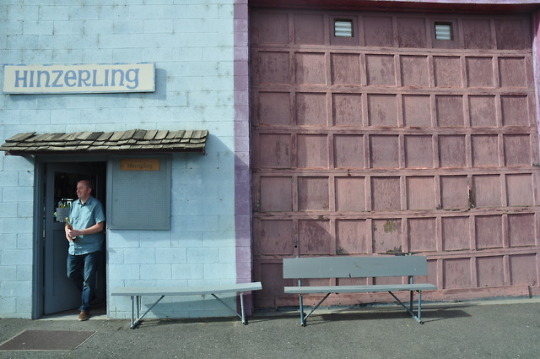
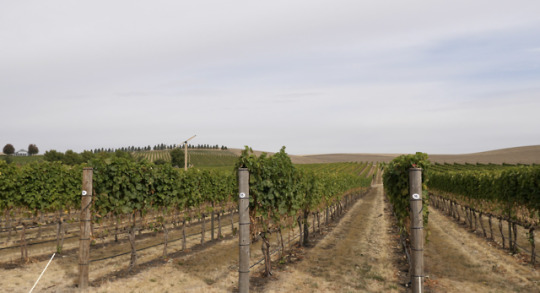
CRUISING WASHINGTON STATE’S WINE COUNTRY.
Eastern Washington is one of the best regions in the United States for growing grapes. There is a rich history of how the wine industry started here. Today some of the best wine globally is produced in this region.
A LITTLE HISTORY, WITHOUT THE BENEFIT OF TASTING.
Wine grapes were -- along with apples -- the very first cultivated fruits in the Pacific Northwest. Initially planted here in 1827, both were cherished by early pioneering settlers, but whereas apples became a lucrative farm commodity early on, the grape's long and winding path to success was a bit rockier. Only in recent decades has both the art and science of viticulture (grape growing) and enology (wine making) really advanced to the point where Washington-grown grapes now share a wide reputation (along with apples) as some of the world's tastiest -- and the finest locally made wines now enjoy global esteem for their excellence.
Seed to Vine, Grape to Wine The first grapes cultivated here (and the wine that they led to) were those grown at Fort Vancouver on the north bank of the Columbia River. This new fur trading post was built in 1825 by the British Hudson's Bay Company (HBC) on a site selected by its manager, Dr. John McLoughlin (1784-1857), who thought that its flat terrain and fecund soil would support a farm that could feed his staff -- and among the various fruits and vegetables planted were grapes and apples.
Both fruits came about as a lucky result of a visitation -- probably by the HBC official, George Simpson (1792?-1860) -- on an inspection tour in November, 1826. Legend holds that: "A gentlemen ... while at a party in London, put the seeds of the grapes and apples which he ate into his vest pocket. Soon afterwards he took a voyage to this country and left them here, and now they are greatly multiplied" (Whitman, Letters and Journals, September 12, 1836). Likely planted during the spring season following Simpson's arrival, the fort was soon receiving shipments of corks and bottles ordered along with other supplies. Overland and by Sea It was the opening of the Oregon Trail that brought the next wave of grape-growing when a number of early emigrants hauled various grape cuttings to the region in their covered wagons -- among the first being Henderson Luelling who babied his vine cuttings all the way out from Iowa. And even though the Isabella variety he'd nurtured was a native North American (Vituslabrusca) hybrid -- rather than the generally superior European (Vitusvinifera) type of wine-grape -- the nursery that he established in the Willamette Valley in 1847 helped other settlers get their homestead vineyards (and wine-making) started. In the northern Oregon Territories -- specifically the Puget Sound area -- a few other folks followed Luelling's example, and by 1854 there were three active nurseries that offered both vinifera and labrusca cuttings to locals. In 1872 that Civil War veteran Lambert Evans (1836?-1917?) arrived in the area and after scouting around via his flat-bottomed skiff, settled on a Stretch Island land claim (near Olympia) and planted grapes and apples on his bluff. Then in 1889, Adam Eckert arrived from New York, bought 40 acres from Evans, founded yet another nursery, and planted Island Belle vines that turned out to be very well suited to the terroir (an area's specific soil characteristics and climate conditions). For the next three decades he supplied cuttings to locals. Willamette to Walla Walla Around 1859-1860 A. B. Roberts hauled grape stock up from the Willamette Valley and planted them along with numerous additional varieties that he imported from France. Around the same time, an Italian baker, Frank Orselli, began making and marketing wine from his shop. Over the next few years, others -- including Phillip Ritz and H. P. Isaacs -- joined in by making wine from grape varieties including Black Hamburg, Black Prince, Flame Tokay, and Sweetwater.
In 1876 Jean Marie Abadie produced 150 gallons of red and 400 of white wine, but in 1883 a 20-degrees-below-zero winter freeze destroyed the area's young grapevines. Then, at the turn of the century, a couple of Italian immigrants named Frank and Rose Leonetti settled in the area and planted Black Prince grapes on their farm and for the next half century they made wine for their family -- including a grandson who would, in due course, kick-start the regional wine biz. The Yakima and Wenatchee Valleys The Yakima River provided the irrigation required to transform the Yakima Valley's scrub-brush desert into a bountiful agricultural area and settlers wasted no time in testing the area's rich volcanic-ash soil's potential for grapes. As early as 1869 a vineyard was planted outside of Union Gap, and within a few years another vineyard in Wenatchee was productive enough to yield an annual total of 1,500 gallons of wine.
By the 1880s Johannisberg Riesling and Mission grapevines had been planted in the tiny town of Moxee. In 1889 H. S. Simmons planted the Zinfandel variety in Wenatchee and the fall harvest of 1893 yielded grapes of a quality that allowed him to make his first wine. Keep on the Sunnyside In 1891 the Sunnyside Canal irrigation project helped accelerate the growth in the Yakima Valley, and a decade later Elbert F. Blaine (1857-?) settled into the valley town of Grandview and -- as the manager of an irrigation company -- was soon touting the possibilities of a serious grape-growing and wine-making industry in the area. The following year of 1903 saw a subsidiary of the Northern Pacific Railroad called the Northwest Improvement Company plant some Kennewick land to various grape varieties.
In 1905 the United States Bureau of Reclamation began a series of irrigation projects that would help launch a new wave of plantings. That same year Blaine began producing wine from varieties including Black Prince, White Diamond, Zinfandel, and Concord. Prohibition Era Sunnyside was also, since 1902, the home of a lawyer named William B. Bridgman (1878-?) who, like Blaine, also managed an irrigation company and took an interest in grapes. In 1917 he planted several varieties of grapevines on some Snipes Mountain acreage near his Harrison Hill farm -- but, that seemed a risky move considering that the Washington State Legislature had enacted severe alcohol Prohibition laws in 1916. However, since the law still allowed for individuals to make small amounts of their own home-brew wine, demand for his grapes was strong. That same "prohibition effect" impacted other grape growers as well: The old Island Belle vines on Lambert Evans's farm were producing grapes that were now sought after by home winemakers and in 1918 a Seattle real estate agent named Charles Somers acquired land from Evans's widow and a new era began. The following year the legislature ratified the 18th Amendment to the United States Constitution and on January 16, 1920, Prohibition spread nationwide. Repeal the Grapes Washington was the 24th state to vote for Prohibition's Repeal, and the national social experiment finally ended with the adoption of the Twenty-first Amendment to the Constitution on December 5, 1933. In the wake of that legal reform, a wave of new companies filed papers with the government to establish new commercial wineries. The first such "bonded" winery in the state was St. Charles Winery -- the firm founded by Somers (and his son C. W. "Bill" Somers) on Stretch Island. The 13th bonded winery was William Bridgman's Upland Winery in Sunnyside, which opened in November 1934 and whose 165 acres of vines produced an amazing 7,000 gallons of wine that first harvest season. That same year saw the rise of two other notable firms: Grandview's National Wine Company (aka Nawico) and Seattle's Pommerelle Winery (Dearborn Street) which, upon Repeal, shifted from making apple juice to apple wine. Grape Expectations The year 1935 saw the first attempt to organize the state's winemakers with the formation of the Washington Wine Producers Association -- and, interestingly, all if its charter members were wineries based in the "un-sunny side" of the state: St Charles Winery, Pommerelle Winery, Davis Winery (Stretch Island), Wright Winery (Everett), and Werberger Winery (Harstene Island). The future looked bright. By 1937 Washington was home to 28 wineries, and by 1938 there were 42 wineries. With all this increased activity, the Washington Wine Producers Association reorganized in 1938 as the Washington Wine Council and further strides were made to establish the region's grape and wine industries.
One promising development was the hiring of Dr. Walter J. Clore (1911-2003) as an assistant horticulturist at the Irrigated Agriculture Research Extension Center near the Yakima Valley town of Prosser. Upon the suggestion of Bridgman, Clore -- who the State Legislature would eventually declare "Father of the Washington State Wine Industry" -- launched the experimental planting of seven vinifera varieties along with 20 labrusca hybrids. That led to the systematic study of more than 250 grape varietals, and over the following 40 years Clore's advice about grapes, soil types, and other viticultural matters contributed immeasurably to the planning of many of the finest local vineyards. (The groundbreaking for the long-planned Walter Clore Wine and Culinary Center -- an ambitious 17,537-square-foot educational facility on a 22-acre site along the Yakima River in Prosser -- will occur in 2009.) Interestingly, with all those many varieties being studied by Clore, it would be the old standby -- Concord grapes -- that would initially raise local expectations for the future of the biz in Eastern Washington. In 1949 that California's giant Ernest & Julio Gallo corporation purchased a remarkable 4,000 tons of the locally grown grapes and the subsequent popularity of Gallo's "Cold Duck" sparkling wine ensured many years of successful collaboration. But 1949 also had a down side: a particular icy winter that year (and again in 1950) effectively destroyed vineyards -- as well as the area's grape business. A Wine Renaissance The 1950s saw many changes on the Washington wine front -- with a major one being the ongoing evolution of local wine palates trending away from what one historian described as the "ghastly quality" of the unsophisticated wines produced here: Local "winemakers then produced fewer gallons of grape wine than of fruit and berry wines, 35 per cent of which were fortified with brandies to yield a strong, sweet domestic liquid dismissed by most wine drinkers as simply garbage for the 'wino' trade" (Clark, The Dry Years, 259). Proof of that qualitative shift was the fact that by 1960, decreased demand accounted for a paltry four wineries remaining active in Washington. But the dawn of the 1960s soon brought a resurgence of activity: 1962 saw a gaggle of winemaking hobbyists led by University of Washington professor Lloyd S. Woodburne (1906-1992) forming the Associated Vintners group which planted a vineyard in Prosser. Believing that red vinifera grapes would never survive there, they opted for Northern European cool-climate varieties like Gewürztraminer and Riesling. Although time would prove their red-wine theory to be inaccurate, one of their Gewürztraminer wines was tasted in 1967 by America's venerated vintner, the California-based Beaulieu Vineyard's Andre Tchelistcheff (1901-1994), who deemed it "the best in the United States." Such accolades convinced Associated Vintners to go commercial and by 1984 the group had morphed into Woodinville's Columbia Winery -- by 2007, the seventh-largest in the state. Washington's largest winery for decades (until Columbia Crest surpassed its production volume) was Chateau Ste. Michelle -- a commercial giant that emerged in 1967 from the American Wine Growers company (which itself formed in 1954 with the merging of the old Concord and fruit-wine purveyors, Pomerelle and Nawico). Starting with a 15,000 gallon production of Cabernet Sauvignon, Pinot Noir, Semillon, and Grenache Rosé wines -- under the direction of winemaker Howard Somers (1919-2005) (who'd grown up working at his family's St. Charles Winery), and with the mentoring of Tchelistcheff and Clore -- the winery today markets multi-million gallons per year of premium quality wine from its showcase Woodinville facility. Even so, its quality has not faltered: In 1979 Tchelistcheff was able to describe the Cabernet Sauvignon as "one of the best I've ever tasted." The Wine Buzz A lot of the buzz about Washington wines surrounds a number of vastly smaller wineries that have emerged since the 1970s. That was when a few "mom and pop" start-ups like Hinzerling Vineyards, Kiona Vineyards, Hogue Cellars, Chinook Wines, Barnard Griffin Wines, L'Ecole No 41, Mercer Ranch, McCrea Winery, and Portteus Vineyards got underway. The first to capture public attention was Preston Wine Cellars, which began in 1972 when Bill and Joann Preston planted their 50-acre vineyard outside of Pasco. In 1976 the couple opened what was the region's first "destination" winery and by 1979 their 180-acre vineyard was planted to cabernet franc, cabernet sauvignon, chardonnay, gamay noir, gewürztraminer, merlot, sauvignon blanc, syrah, and white riesling. The first winemaker to really make waves was Gary Figgins -- the grandson of those Walla Walla pioneers, Frank and Rose Leonetti. Figgins' winery, Leonetti Cellar, would go on to garner acclaim for many subsequent vintages -- but he initially shocked the wine world when his 1978 Cabernet Sauvignon earned kudos from the Winestate Wine Guide as the "best in the country," and later, when pitted in a competition against all the big California masters, was named "Best of The Best." Inspired by Figgins's activities, his friend Rick Small planted 26 acres of vineyards in 1976, founded the Woodward Canyon winery in 1981, and his subsequent Chardonnay, Merlot, and Cabernet wines have won an intense following, many top awards and -- like Leonetti -- a well-earned status as one of the state's finest wineries. Another star in the Washington wine galaxy is Quilceda Creek Vintners, which was founded at Snohomish in 1979 by Alex Golitzin after receiving encouragement from his uncle, Tchelistcheff. Golitzin's Cabernets have consistently been jaw-droppers and in recent years his highly esteemed wines (the 2002 and 2003 vintages) made history as the first ever from Washington to win perfect "100" scores by the world's top critic, Robert Parker and his Wine Advocate publication. Washington Wine Commission In 1987 the Washington Wine Commission formed as a trade group and a dozen years later it established the Washington Wine Quality Alliance to help forge standards in winemaking and labeling. By 2016 the state boasted 14 unique and officially recognized grape-growing regions -- "appellations" or AVAs (American Viticultural Areas) -- designated by the federal Alcohol and Tobacco Tax and Trade Bureau: Yakima Valley (1983), Walla Walla Valley (1984), Columbia Valley (1984), Puget Sound (1995), Red Mountain (2001), Columbia Gorge (2004), Horse Heaven Hills (2005), Wahluke Slope (2006), Rattlesnake Hills (2006), Snipes Mountain (2009), Lake Chelan (2009), Naches Heights (2011), Ancient Lakes (2012), and Lewis-Clark Valley (2016), with additional AVAs expected in the future. One interesting result is that even certain individual vineyards -- including Alder Ridge, Andrews-Horse Heaven Vineyard, the Benches at Wallula Vineyard, Canoe Ridge, Celilo, Champoux, Champoux Vineyards, Chandler Reach, Charbonneau, Ciel du Cheval, Connor Lee, Klipsun, Pepper Bridge, Red Willow, Roza Berge, Saddle Mountain, and Sagemoor (among Washington's 43,000-plus acres planted to grape) -- have now (like those in various other internationally established wine regions) gained widespread notoriety, and bottles carrying those terms merit instant prestige. So the regional wine industry has certainly come a long way over the years from those early days of sweet fruit-based wines. Today numerous firms -- including Abeja, Andrew Will, Betz Family Winery, Buty, Cadence, Cayuse, DeLille Cellars, Dunham Cellars, Fidélitas, Hedges Family Estate, Januik, K Vintners, Long Shadows, Mark Ryan, Matthews Estate, McCrea Cellars, Owen Roe, Reininger, Rulo, Spring Valley Vineyard, Syncline Wine Cellars, Waters, and Walla Walla Vintners among others -- regularly astound experts, winning regional, national, and/or international awards. Now -- with 750-plus active wineries (and a new one slated to open about every 10 days) -- the local wine trade, with 350 growers and more than 14,000 jobs, currently contributes an estimated three billion dollars to the state's annual economy. Today Washington ranks second only to California in total wine production in the United States and our wine is being shipped to all 50 states and to at least 40 foreign countries -- so word about our "grape juice" has clearly gotten around. Cheers!
This essay made possible by:
The State of Washington Washington Department of Archaeology and Historic Preservation
Originally published in Wine in Washington, History
by: Peter Blecha, HistoryLink.org essay 8658
http://american-mosaic.com
Note: This essay was updated on January 12, 2014, and on September 6, 2017.
0 notes
Photo

Made with the OHS Memory Blanket on June 03, 2019 Collection Patches:
Suffrage Committee Report, 1857
(Collection ID bb016886),
Canoe
(Collection ID 780),
Sun Mask
(Collection ID 86-114.9),
Debate Over Oregon Constitution
(Collection ID bb016799),
Draft of Oregon Constitution
(Collection ID bb016887),
Model of the Ship, Columbia Rediviva
(Collection ID 71-89.1)
0 notes
Photo

Made with the OHS Memory Blanket on April 04, 2019 Collection Patches:
Suffrage Committee Report, 1857
(Collection ID bb016886),
Draft of Oregon Constitution
(Collection ID bb016887),
A Map for William Clark
(Collection ID bb017074),
Cecilia Adams’ Diary
(Collection ID 007858),
Debate Over Oregon Constitution
(Collection ID bb016799),
Sun Mask
(Collection ID 86-114.9)
0 notes